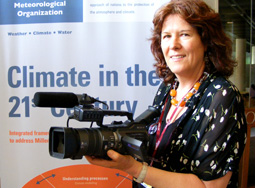 My interest in the forests of Indonesia began in late 2006 when I discovered that over 4,000 orangutans had been killed by deliberately-lit fires in Borneo that year. My partner Jeff Canin was doing some work for the Great Ape Survival Project (GRASP) and showed me sad and horrific pictures of orangutans who had been injured and orphaned by the fires.
My interest in the forests of Indonesia began in late 2006 when I discovered that over 4,000 orangutans had been killed by deliberately-lit fires in Borneo that year. My partner Jeff Canin was doing some work for the Great Ape Survival Project (GRASP) and showed me sad and horrific pictures of orangutans who had been injured and orphaned by the fires.
At about this time, new scientific evidence emerged showing that the destruction and burning of the world’s forests was contributing around 20 percent of global carbon emissions. In fact, during the extreme fires of 1997, they had contributed as much as 40 percent of global emissions.
I decided I wanted to make a film about the importance of forests not only as threatened habitat for endangered species like orangutans, but also in relation to climate change. After the massive fires in Indonesia during the burning season of 2006, which by some estimates were calculated to contribute almost 15 percent of global carbon emissions for that year, Indonesia was ranked as the third largest emitter of greenhouse gases in the world.
In December 2006, in relation to another project we were developing, I met a young man who had achieved considerable success in building online communities. By chance he happened to mention that he was also looking at the problem of deforestation in Indonesia and was setting up a small carbon trading company as part of his proposed solution. His idea involved selling the carbon credits represented by large forest areas to big carbon emitters in the West. I asked him if I could follow his progress, and so my year-long journey of tracking Dorjee Sun and his quest for a solution began.
At the 2007 Documentary Conference in Adelaide, I met Leonard Retel Helmrich, a celebrated cinematographer who agreed to shoot the film. His relatives in the province of Jambi are in the business of growing oil palms. That is how I met small-time farmer, Achmadi. Achmadi had recently purchased more land which he intended to clear and burn to increase his output of palm oil. Used in cooking, cleaning and cosmetic products, palm oil is also increasingly in demand for biofuel in a world hungry for alternative energy. Achmadi needed the income to feed his family and put his daughter through school. He was unaware that his fires were contributing to global carbon emissions.
My objective in telling this story is to give audiences the opportunity to observe a young man as he goes on a quest to find a solution to the forest crisis, see the huge obstacles and opposition he confronts, and despite enormous odds, watch him pull off a big deal. Who actually benefits from the deal remains a central question of the film. No one yet knows the answer. This is a pioneer scheme and there are no precedents. We do know that a major international bank, Merrill Lynch, is prepared to risk millions on this business. Only a sequel will reveal whether it delivers on its promises. At least in the short-term, the deal will ensure that 750,000 hectares of forest will not be logged, that 1,000 ex-combatants have been recruited to protect the forest, and that the habitat of numerous endangered species, including the Sumatran orangutan, will be protected.
Skeptics might conclude that the concept is flawed, that Dorjee’s motivation is purely selfish and that the scheme probably won’t work. Carbon trading as a concept is questioned by various protagonists in the film and at almost every meeting Dorjee attends in the middle section of the film. Achmadi’s entire storyline is about the difficulties and improbability of the money from carbon trading ever reaching the village level. Skeptics can draw their own conclusions.
I personally do not have great admiration for skeptics. It is far easier to criticize something than to go out and try to fix the problem. I am more interested in the views of young people and optimists. Dorjee’s quest can be interpreted as an inspiration for young people to believe that change is possible. Whether he succeeds or not, he is not just accepting the world as it is. He is looking for new ways of saving forests. And he proposes the radical idea that making money from saving the environment is possible.
I see Dorjee as a flawed and fascinating character, and I see his solution, and carbon trading in general, as a flawed but necessary solution. Without some form of carbon trading, I doubt we have a hope of stopping the mass destruction of forests in the next decade. And without protecting forests, and giving a value to the services they provide to the planet, solving the climate change crisis seems less likely. I hope that the film continues to raise these issues and that heated discussion will continue after every screening of the film.
